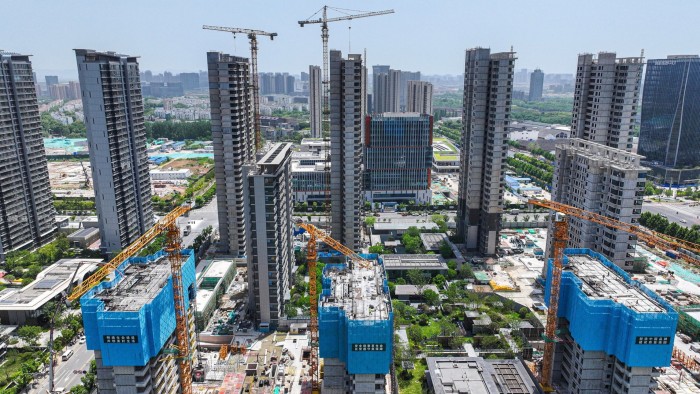Just days after Premier Li Qiang called for “greater efforts” to halt a decline in China’s housing market, fresh data on Monday laid out why the country’s top leadership still has such cause for concern.
New home prices across 70 Chinese cities fell 0.2 per cent in May from the previous month, while those of second-hand homes declined 0.5 per cent, according to a Financial Times analysis — the fastest pace of decline in seven and eight months respectively.
Real estate investment was also down 10.7 per cent in the first five months of 2025, the data showed.
Years after Chinese home prices started to fall following a series of developer implosions, the prospect of a stabilisation remains in doubt, piling pressure on policymakers as they contend with a weaker economic backdrop.
“A nationwide turnaround looks a distance away,” said Louise Loo, lead economist at Oxford Economics.
Sentiment was buoyed earlier this year by data showing a moderation in falls, and month-on-month growth in prices in tier 1 cities, in a period after Beijing unleashed a series of supportive measures in September.
But any sense of improvement stalled in May, despite a trade war truce with the US.
“Even the primary prices started to see some weakness,” said Karl Choi, head of Greater China real estate research at Bank of America, of the May figures. “That was a bit of a difference from the last few months, when primary prices were relatively stable.”
The setback comes despite numerous government efforts to support the market, including mortgage rate cuts, funds to complete unfinished residential projects and plans to convert unused homes into social housing.
Housing prices are typically measured through sales of new homes, reflecting China’s rapid pace of urbanisation. But the secondary home market was “a more definitive gauge of sentiment, given looser price controls”, said Loo, who noted that second-hand prices were flat or rose in just three of 70 cities tracked by the National Bureau of Statistics in May.
The property market was “still searching for a bottom”, said Jian Chang, chief China economist at Barclays, pointing to recent declines in secondary market prices in big cities following “some stabilisation in March”.
Top cities, where housing is still expensive, have scrapped purchase restrictions to try to restore confidence, with the latest announcement coming from Guangzhou last week. Monthly price changes for new homes in tier-one cities turned negative in May for the first time this year, and fell sharply for second-hand homes.
Other indicators paint a less gloomy picture. Prices are falling less steeply on a year-to-year basis, with new home prices declining 4.1 per cent in May compared with more than 6 per cent in October.
Michelle Kwok, head of Asia real estate research at HSBC, suggested that “things have already started to turn” from the depths of the now four-year crisis. “Big cities are leading the recovery,” she said.
Most economists had not anticipated a return to rising prices for some time, even before the added setback of a full-blown trade war with the US.
“Stabilisation, much less recovery, is not expected in 2025,” said Yuhan Zhang, principal economist at the Conference Board’s China Center. He added that “oversupply remains a serious challenge”, though he noted that inventory levels were expected to rise less quickly than last year.
John Lam, property analyst at UBS, said uncertainty around tariffs had delayed a recovery in tier-one cities in April but stabilisation might still be possible in the fourth quarter. Yi Wang, a Goldman Sachs property analyst, said she did not expect spot prices in the primary or secondary markets to stabilise until the second half of next year.
Further afield, the nationwide picture poses an acute challenge to policymakers. Goldman Sachs on Monday forecast that urban demand for new properties would remain below 5mn units per year in the coming years, down from a peak of 20mn in 2017.
Han Jun, who runs a trade advisory business in the textile manufacturing capital of Keqiao in coastal Zhejiang province, said last month that local housing prices had fallen about one-third from their peak. “They keep going down, and it doesn’t look like it’s turning around,” he said.
Li, in comments that were read out on state broadcaster CCTV, called on policymakers to “focus on the long term”.
But if there are still doubts over China’s richest cities, the recovery remains even more uncertain outside of them.
“We go as far as saying, just write off the lower tier,” said Kwok at HSBC. “We just have to accept that it’s not going to be a ‘rising tide lifts all boats’ coming out of this crisis.”
Additional reporting by Ryan McMorrow in Shaoxing, Wenjie Ding in Beijing and Wang Xueqiao in Shanghai

